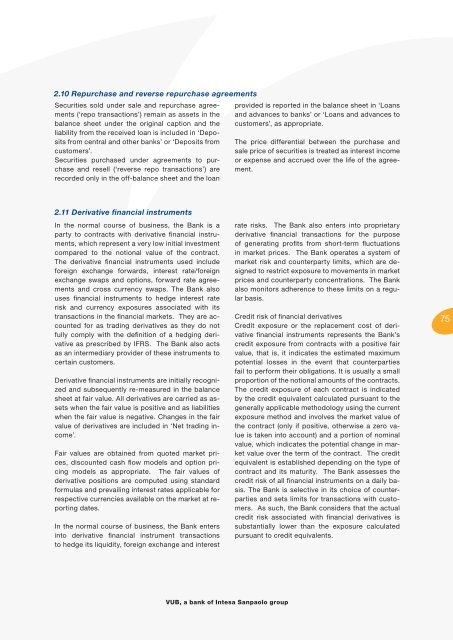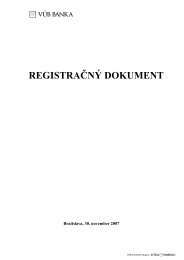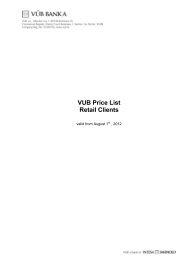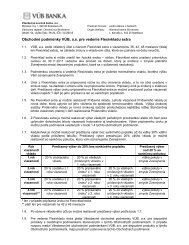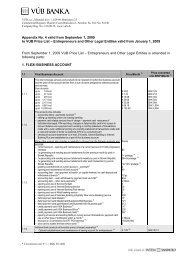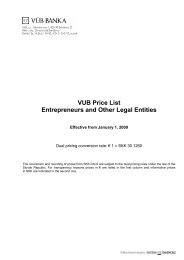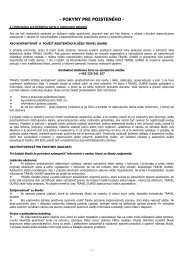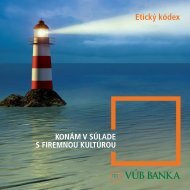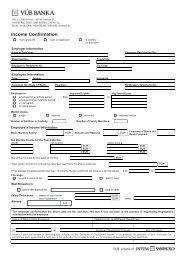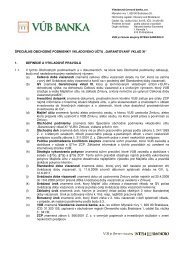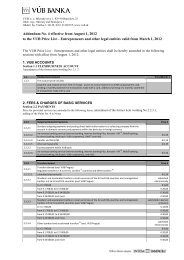Annual Report - VÃB banka
Annual Report - VÃB banka
Annual Report - VÃB banka
Create successful ePaper yourself
Turn your PDF publications into a flip-book with our unique Google optimized e-Paper software.
2.10 Repurchase and reverse repurchase agreements<br />
Securities sold under sale and repurchase agreements<br />
(‘repo transactions’) remain as assets in the<br />
balance sheet under the original caption and the<br />
liability from the received loan is included in ‘Deposits<br />
from central and other banks’ or ‘Deposits from<br />
customers’.<br />
Securities purchased under agreements to purchase<br />
and resell (‘reverse repo transactions’) are<br />
recorded only in the off-balance sheet and the loan<br />
provided is reported in the balance sheet in ‘Loans<br />
and advances to banks’ or ‘Loans and advances to<br />
customers’, as appropriate.<br />
The price differential between the purchase and<br />
sale price of securities is treated as interest income<br />
or expense and accrued over the life of the agreement.<br />
2.11 Derivative financial instruments<br />
In the normal course of business, the Bank is a<br />
party to contracts with derivative fi nancial instruments,<br />
which represent a very low initial investment<br />
compared to the notional value of the contract.<br />
The derivative fi nancial instruments used include<br />
foreign exchange forwards, interest rate/foreign<br />
exchange swaps and options, forward rate agreements<br />
and cross currency swaps. The Bank also<br />
uses fi nancial instruments to hedge interest rate<br />
risk and currency exposures associated with its<br />
transactions in the fi nancial markets. They are accounted<br />
for as trading derivatives as they do not<br />
fully comply with the defi nition of a hedging derivative<br />
as prescribed by IFRS. The Bank also acts<br />
as an intermediary provider of these instruments to<br />
certain customers.<br />
Derivative fi nancial instruments are initially recognized<br />
and subsequently re-measured in the balance<br />
sheet at fair value. All derivatives are carried as assets<br />
when the fair value is positive and as liabilities<br />
when the fair value is negative. Changes in the fair<br />
value of derivatives are included in ‘Net trading income’.<br />
Fair values are obtained from quoted market prices,<br />
discounted cash fl ow models and option pricing<br />
models as appropriate. The fair values of<br />
derivative positions are computed using standard<br />
formulas and prevailing interest rates applicable for<br />
respective currencies available on the market at reporting<br />
dates.<br />
In the normal course of business, the Bank enters<br />
into derivative fi nancial instrument transactions<br />
to hedge its liquidity, foreign exchange and interest<br />
rate risks. The Bank also enters into proprietary<br />
derivative fi nancial transactions for the purpose<br />
of generating profi ts from short-term fl uctuations<br />
in market prices. The Bank operates a system of<br />
market risk and counterparty limits, which are designed<br />
to restrict exposure to movements in market<br />
prices and counterparty concentrations. The Bank<br />
also monitors adherence to these limits on a regular<br />
basis.<br />
Credit risk of fi nancial derivatives<br />
Credit exposure or the replacement cost of derivative<br />
fi nancial instruments represents the Bank’s<br />
credit exposure from contracts with a positive fair<br />
value, that is, it indicates the estimated maximum<br />
potential losses in the event that counterparties<br />
fail to perform their obligations. It is usually a small<br />
proportion of the notional amounts of the contracts.<br />
The credit exposure of each contract is indicated<br />
by the credit equivalent calculated pursuant to the<br />
generally applicable methodology using the current<br />
exposure method and involves the market value of<br />
the contract (only if positive, otherwise a zero value<br />
is taken into account) and a portion of nominal<br />
value, which indicates the potential change in market<br />
value over the term of the contract. The credit<br />
equivalent is established depending on the type of<br />
contract and its maturity. The Bank assesses the<br />
credit risk of all fi nancial instruments on a daily basis.<br />
The Bank is selective in its choice of counterparties<br />
and sets limits for transactions with customers.<br />
As such, the Bank considers that the actual<br />
credit risk associated with fi nancial derivatives is<br />
substantially lower than the exposure calculated<br />
pursuant to credit equivalents.<br />
75<br />
VUB, a bank of Intesa Sanpaolo group


